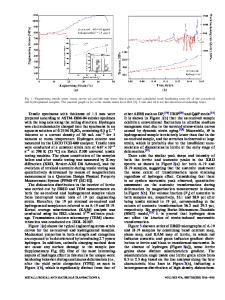Evaluation of the Role of Deformation Twinning in Work Hardening Behavior of Face-Centered-Cubic Polycrystals
- PDF / 726,380 Bytes
- 10 Pages / 593.972 x 792 pts Page_size
- 99 Downloads / 366 Views
UCTION
DEFORMATION twinning is considered to be the main mechanism responsible for the high strain hardening rates observed in most low stacking fault energy (SFE) face-centered-cubic (fcc) alloys.[1] This idea principally stems from both the geometry of deformation twins[2–4] and experimental data showing occurrence of deformation twins with concurrent increase in work hardening rate.[1,5] Deformation twins in fcc alloys are R3 boundaries, which may form ‘‘semi-rigid’’ obstacles against noncoplanar slip systems.[6] A moving dislocation on an active slip system will face difficulties crossing a twin boundary, which is usually located on conjugate (and rarely on critical) slip systems. These obstacles are somewhat permeable by certain dislocation reactions, such as those suggested by Mahajan and Chin[2] and Remy.[3,4] However, these reactions are not energetically favorable and are more likely to occur at regions of high local stresses, e.g., dislocation pile-up fronts. As a result, deformation twins are considered to subdivide grains in which they form, causing additional increase in work hardening rate of the material. The other probable geometrical parameter by which deformation twinning may contribute to strain hardening is through orientation change in the twinned crystal. Orientation related FARZAD HAMDI, Graduate Student, and SIROUS ASGARI, Associate Professor, are with the Department of Materials Science and Engineering, Sharif University of Technology, Tehran, Iran. Contact e-mail: [email protected] Manuscript submitted April 16, 2007. Article published online December 28, 2007 294—VOLUME 39A, FEBRUARY 2008
contribution of twinning in hardening of materials is of more significance in lower symmetry as well as mechanically anisotrope alloys, such as highly textured hcp metals.[7,8] In these materials, twinning may reorient the grain in which it forms leading to a change in resolved shear stress for active slip system. Recent studies have revealed that in fcc polycrystalline alloys of low SFE, the strain hardening behavior is distinctly different from that of materials of higher SFE values.[1,9,10] A detailed work performed on MP35N*, *MP35N is a trademark of SPS Technologies Inc., Jenkintown, PA.
a low SFE Ni-Co base alloy, showed different aspects of this behavior.[1] It is characterized by occurrence of two plateaus in strain hardening rate vs strain plots as schematically shown in Figure 1. In the early stages of deformation, up to a true strain of about -10 pct, a continuous decrease in strain hardening rate is observed (stage A). This behavior is comparable with the stage III of hardening in higher SFE fcc alloys (e.g., copper, Figure 1). Stage A is followed by a second hardening regime, stage B, in which the hardening rate is almost constant and is manifested by a linear region in true stress vs true strain curve. This behavior differs from hardening response of fcc alloys of higher SFE values. Following stage B, another fall in strain hardening rate is observed at strain levels higher than about -25 pct.
Data Loading...











